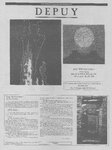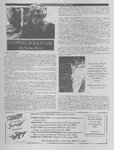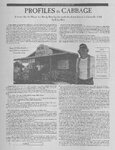| OCR Text |
Show WOLVERTON'S WAR on WEEDS WHEN IT COMES TO TAMARISK & RUSSIAN OLIVE, GARFIELD COUNTY'S BILL WOLVERTON SHOWS NO MERCY BY JULIE COZBY “There’s one.” Bill Wolverton, National Park Ranger, kneels and removes his pack. A very small Tamarisk stands next to the trail, its lace-like greenery changing into a fall peach- American Southwest. “No,” says Bill with regret. “It’s just too ... too entrenched.” tone, not unlike the shift in the new $20 bills. Russian Olive. He agrees, but hands me an eleven-page memo he sent to his Resource Management superiors at Glen Canyon. “Read this first. Then ask me questions.” In fact, it’s actually quite pretty, resembling an ostrich feather. He rummages through exterior zip pockets to find small, rubber-handled pruning shears and an old film canister, the kind that’s aluminum with a twist cap. “Ts that poison?” Task. “Yep,” he says. He opens the film can and pours Garlon herbicide into a 4 ounce bottle with a dropper tip. He snips down the little Tamarisk plant, then squeezes the poison onto the small stem that still remains. “That will kill it?” Task. eYep.< Later, I ask Bill for some time to sit down and discuss his obsession with Tamarisk and I find that the memo is a detailed account of Bill’s work by himself and with th volunteer groups to kill off the intruding plants and trees. His final observation? : “Bradicating Russian Olive from the Escalante River canyons is going to be a huge job, and is going to take several years. It will not be easy, and constant follow up will be required to maintain control of it. However, it can be done, and the consequence of not doing it is to allow the Escalante and its side canyons to become a nearly continuous monoculture of Russian Olive from one end to the other, with nearly all the native’ vegetation replaced by the invader.” This is what it’s like to hike with Bill Wolverton. If there are non-native plants growing anywhere near his route, he will kill with impunity. Wolverton is a seasonal ranger with Glen Canyon National Recreation Area in the Escalante sub district. His mission has been . to remove Tamarisk plants and Russian Olive trees within the Canyons of the Escalante. The task is almost overwhelming. The whole business of killing trees is a surprise to me if someone has had a calling to be a National Park Service Ranger. But the trees are not nativethey are alien invaders intent on total domination. Wolverton has lead Sierra Club Service Trips and Wilderness Volunteers on plant murdering sprees in the canyons, carrying pruning saws, loppers and sprayers in addition to their hiking gear. Some have called it the most rewarding hike of their whole lives. Others have struggled to keep up with Wolverton’s pace--and passion. On these latest trips, volunteers have even carried chain saws across the desert sands and down into the canyons to rid the waterways of the larger trees. Cattle have not been allowed to graze in the canyons on the rec area for over twelve years, and the plants have literally taken over. And it’s not just the Tamarisk and Olivewillow, maple, rabbit brush, and native grasses have returned in abundance as well. In the “Thought you'd like that,” Bill chuckles. Photo by I decide to join Bill on the cattle fence patrol. I thought it would be a great way to killa Sunday morning. As a new volunteer with the Park Service, I didn’t know exactly what to expect; I soon found out that there is plenty of manual labor involved. Bill hikes very quickly. I had heard rumors from the people that had hiked with him on other trips that his pace was a bit too fast, that keeping up with Bill was really tough. Naturally, I was a little concerned that I wouldn’t be able to hack a hike with him. But his pace was just fine with me, and we sped through about five miles in the canyon bottoms that day. At two miles in, Bill snipped the little Tamarisk. At four miles in, Bill pointed to a canyon wall. “Look over there. There are some pictographs you might be interested in,” Bill said. I walked over to the canyon wall and sure enough there was an old standby, Devil Guy. Devil Guy is everywhere in southwest rock art. Whether it’s a pictograph or petroglyphs, Fremont or Anasazi, Devil Guy is pretty popular--more so than Kokopelli, but just not as aesthetically pleasing. This particular rendition of Devil Guy had a large male organ- Julie Cozby desert, where there’s water there’s plant life. But the plants that keep Bill Wolverton awake at night are Tamarisk and Russian Olive. Every fall, the Park Service has to place seasonal cattle fences in the bottom of side canyon entrances into Coyote Gulch, a tributary of the Escalante River. The fall colors down in the deep red and black-streaked canyon are gut wrenching in their intensity. The beauty is. so impossible that it takes your breath away. It’s like being in Las Vegas for the first time, but the sensory overload is nature in the raw. And then you fall in love with the place. Apparently Bill is married to the canyons; the two are inextricably joined, and Bill is fulfilled in this relationship. BILL WOLVERTON...WEED WARRI OR After I stop and look a bit, we walk on. About 10 yards later, Bill turns around. “I put a Russian Olive over by those paintings. Didn’t you see it? I cut it down a few days ago and decided to put it there to test you, see if you saw it or even recognized it! YOU WERE TOO BUSY LOOKING AT ROCK ART!” Icringe. “Bill you're making me feel bad,” I say. “Good!” he says. I feel a bit of the showman seeping into Ranger Bill. His voice rises and he shakes his fists in the air. “At least my life has been lived for some better reason. I’ve taught you to feel bad for not seeing that plant.” I’ve just been shamed into identifying non-native plant species. 1 keep my head up and my eyes peeled while hiking from that moment on. “So Bill...do you kill Russian Thistle, too?” Russian Thistle, better known as tumbleweed, has established itself well in the ti Cae a =~ Looking at Bill, he reminds you of someone that should be pushing paper in an office somewhere. His thick glasses and his deliberate conversational style click with his old day job: mechanical engineer for the Southern Pacific Railroad. He was laid off in 1982. He took odd jobs and lived off of his savings until he sold his house in California and bought his Escalante house outright in 1986. He had been hiking the Escalante Canyons since 1979, and since he was enamored with the country, he decided to make Escalante his home. “I wouldn't live anyplace else,” he says. He became a part-time park ranger in 1988 because he admired the people doing the job. He added, “I was also out of a job and needed to do something.” PRINTS Wh 1h ia ve (Ss y \ : \ silence is golden? iy / WINNER OFTHE2004 EXCELLENCE IN TECNOLOGY TN aN SB | PAGE 12 WHAT DO WE DO? We write custom software for the big people and the little...OK:..We take that real big file cabinet full of paper and put it all into your computer. 121 E. 100S. #108 Moab, UT 84532 435.259.4384 800.635.5280 |


































